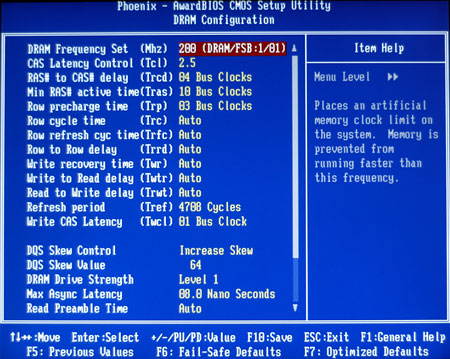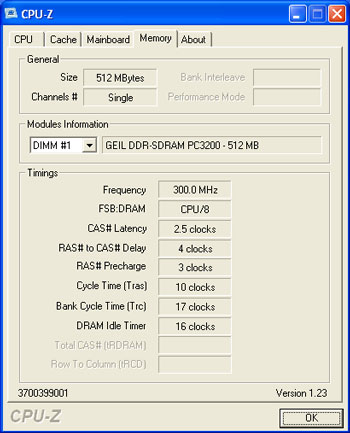DFI LANParty UT nF3-250Gb: Overclocker's Dream
by Wesley Fink on September 8, 2004 12:05 AM EST- Posted in
- Motherboards
FSB Overclocking: DFI LANParty UT nF3 250Gb
DFI has given users just about everything that they could ask for in the way of overclocking options. So, what can you do with all those wonderful options for overclocking? We have already seen great results from the MSI K8N Neo and other Socket 754 boards, so we hoped that we could do even more with the DFI LANParty UT. We weren't disappointed.| Front Side Bus Overclocking Testbed | |
| Default Voltage | |
| Processor: | Athlon 64 3200+ 2.0GHz |
| CPU Voltage: | 1.5V (default) |
| Cooling: | Thermaltake Silent Boost K8 Heatsink/Fan |
| Power Supply: | OCZ Power Stream 520W |
| Hard Drive: | Maxtor MaXLine III 250GB SATA (16MB Cache) |
| Memory: | OCZ PC3200 EL Platinum Rev. 2 or Geil PC3200 Ultra X |
| Maximum OC: (Standard Ratio) |
248x10 2470MHz (+24%) |
| Maximum FSB: (Lower Ratio) |
308 x 8 {1:1 Memory, 1 DIMM) 270 x 9 at (1:1 Memory, 2 DIMMs) |
This late 3200+ tops out around 245 to 246CPU setting at stock multiplier on the best overclocking boards. It reached 248 on the DFI nF3 250Gb at stock 10X ratio and stock voltage, which should be considered the limit of this CPU.
The performance at lower ratios, on the other hand, took our memory to performance levels never reached on any board - AMD or Intel. Both the Geil and OCZ memories are based on very recent Samsung TCCD memory chips, which performed well in our recent memory tests on an Intel test bed. They topped out at DDR557 to 561 on the Intel, so I was skeptical when DFI told me that TCCD memory could reach DDR600 on the nF3-250Gb. With a little tweaking, we were able to reach even further with this same memory, to DDR616 at 3-3-4-10 memory timings at 2.8V memory voltage.
It is significant that these record 1:1 overclocks were achieved with a SATA hard drive, since SATA drives are often an issue when overclocking Intel 775 boards. The SATA lock certainly appears to be working very well on this production DFI nVidia nF3 250Gb board.

DDR616 is the highest memory speed that we have ever reached on any board in our overclocking, with this memory or any other including DDR550. When you consider this is a 54% overclock of the memory's rated speed of DDR400, it puts into perspective the astounding performance of this memory on the DFI nF3 250Gb. To give you a better idea of what it took to reach DDR616, below is a BIOS shot of the memory timings to reach this milestone.

With a bit more tweaking, we managed to reach stable DDR600 performance with 2.5-3-4-10 memory timings with the OCZ and Geil at memory voltage of 2.8V. These are really aggressive timings for a memory running at DDR600.

We were able to achieve even faster 2.5-2-2-10 timings at DDR586 with OCZ3700EB, but it required the board limit of 3.1V to achieve stability at this speed. We have seen reports on the web of some achieving near DDR600 with OCZ3700EB on the beta DFI with 3.2V.
Please keep in mind that these incredible overclocks were achieved with 1 DIMM in this single channel board. We also tested 2 DIMMs of the same memory and found that we topped out at 270 CPU setting (DDR540) with the TCCD DIMMs. The "Auto" setting on Hyper Transport speed seemed to handle anything we threw at the DFI without complaint.
Front Side Bus Stress Test Results:
As part of our overclocking tests, a full range of stress tests and benchmarks were run to ensure that the DFI LANParty UT was stable at each overclocked FSB speed. This included Prime95 torture tests, and the addition of other tasks - data compression, various DX8 and DX9 games, and apps like Word and Excel - while Prime95 was running in the background. Finally, we ran our benchmark suite, which includes Veritest Winstone 2004 suite, Unreal Tournament 2003, SPECviewperf 7.1, and Aquamark 3. 248MHz was the highest overclock that we were able to achieve with the DFI while running these tests at default voltage - an outstanding performance with the Athlon 64.We were also able to complete stress testing at 300x8 with 2.5-3-4-10 memory timings. At that speed of 2.4Ghz at DDR600, we achieved the following results:
- Quake 3 - 474.0
- Return to Castle Wolfenstein-Enemy Territory-Radar - 104.3
- Sisoft Sandra 2004 - Standard Buffered - 4670/4673
- Sisoft Sandra 2004 - UnBuffered - 2583/2600










54 Comments
View All Comments
alex1971 - Wednesday, September 8, 2004 - link
alex1971 - Wednesday, September 8, 2004 - link
I think its tested with Raid 3+4 that are the two native Ports directly at NF250GB.The Ports 1+2 are native also, but have to use an external PHY.
This Ports 1+2 are finished when HTT > 240 MHZ !!
Try it.....
Remeber: Main S-ATA Problems only at PORT 1+2 because of the PHY .....
Jeff7181 - Wednesday, September 8, 2004 - link
Glad I didn't buy a MSI K8N Neo Platinum yet... I'll wait for this board before I go A64. =)SLIM - Wednesday, September 8, 2004 - link
Great article man, but I almost blew by the part where you mentioned that the Far Cry and UT results were with a 9800pro vs 6800ultras. You might consider putting asterisk on those graphs and bold or highlight the huge difference in graphics cards.It might help those who prefer to only look at the pretty pictures.
SLIM
PS: I second the Iwill board review request.
SUOrangeman - Wednesday, September 8, 2004 - link
Review request: http://www.iwillusa.com/products/ProductDetail.asp...Although this is not a 754-pin mobo, the experience should be great nonetheless!
-SUO
at80eighty - Wednesday, September 8, 2004 - link
i second..umm...third...punko's Anantech's "Overclocking for Dummies" idea...i'd LOVE to dig into my rig...but it kinda scares me if i f*ckup : )
Myrandex - Wednesday, September 8, 2004 - link
I think the yellow looks cool, but a UV reactive plastic would have been cool along with it. This does seem a bit more of a 'budget' type board when compared to other LanParty series boards. I sure do like it a lot, and I have considered moving from my old MSI K8T Neo board to this one (so I am kinda happy about it being S754). I do wonder about the two SATA cables near the AGP socket, as they are extremely out of the way, and it brings more cable clutter to the center of the board.Wesley Fink - Wednesday, September 8, 2004 - link
#16 - The test bed had a MaXLine III 250GB SATA hard drive with 16MB of buffer. We first tested with the SATA on Channel 1 between the AGP slot and the CPU -- the plan was to see where SATA failed and then switch to IDE to find the top OC. When we reached DDR600 then DDR616 while running this SATA drive we saw no point in the IDE switch. This board is really stable in OC - even with SATA.rjm55 - Wednesday, September 8, 2004 - link
You say on page 6 that you ran the overclocking tests with a SATA hard drive. Can you please confirm that you did DDR616 running a SATA hard drive, because I've read that SATA drives can hold back overclocking.Avalon - Wednesday, September 8, 2004 - link
*drool*